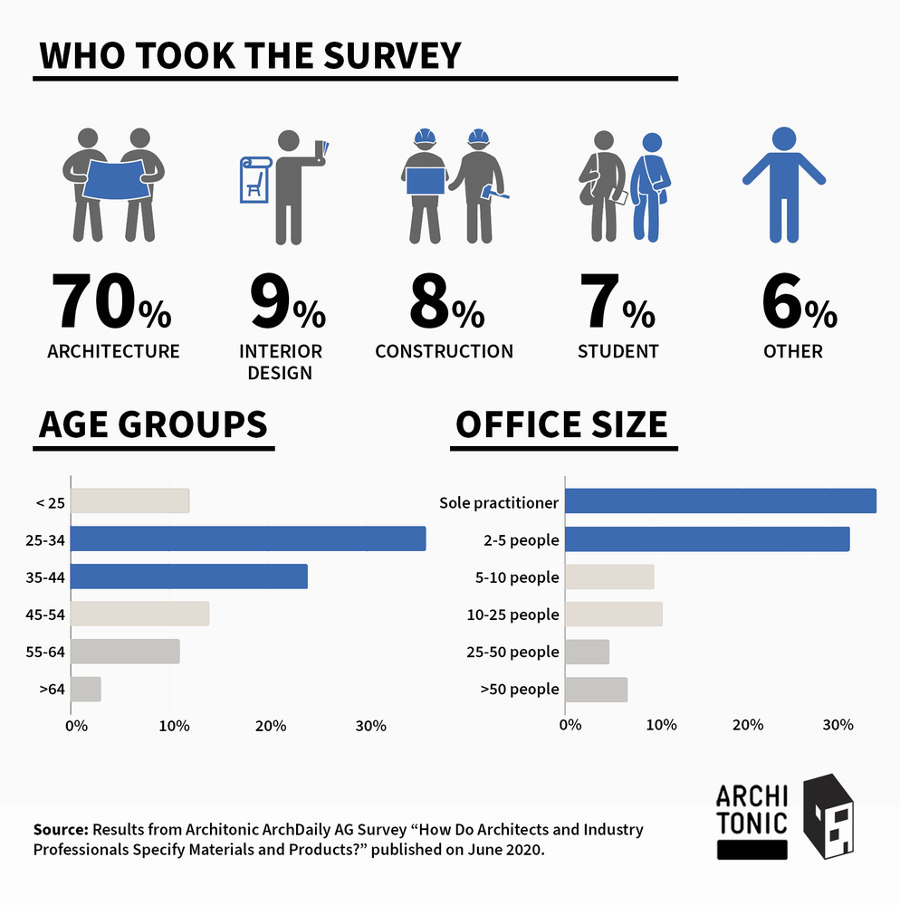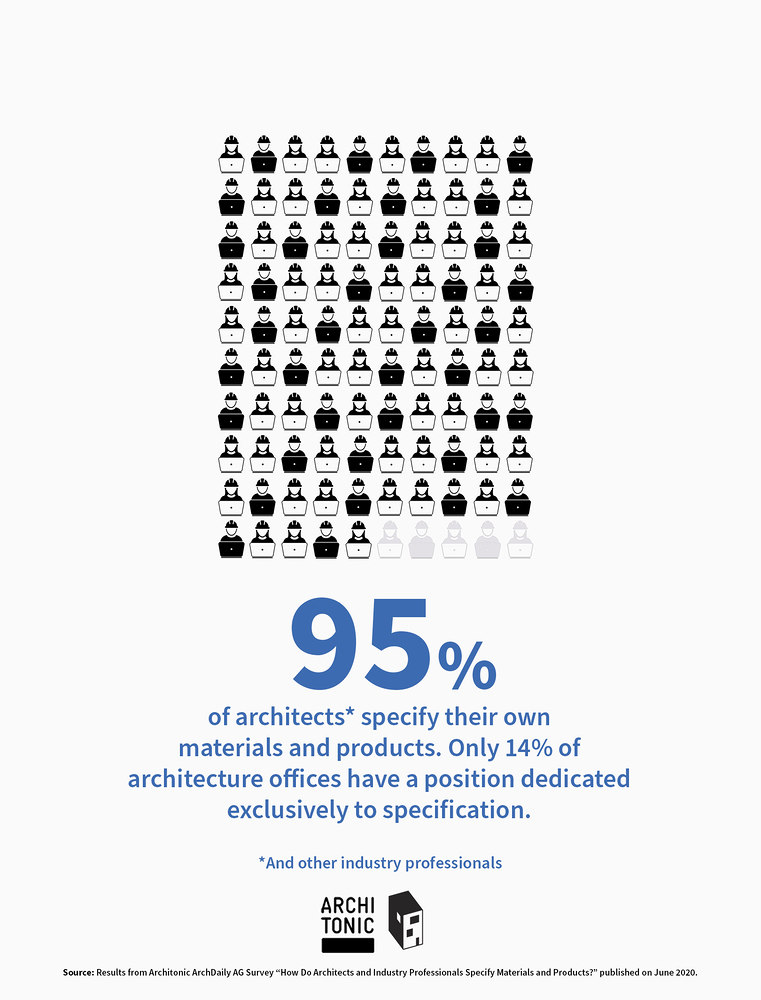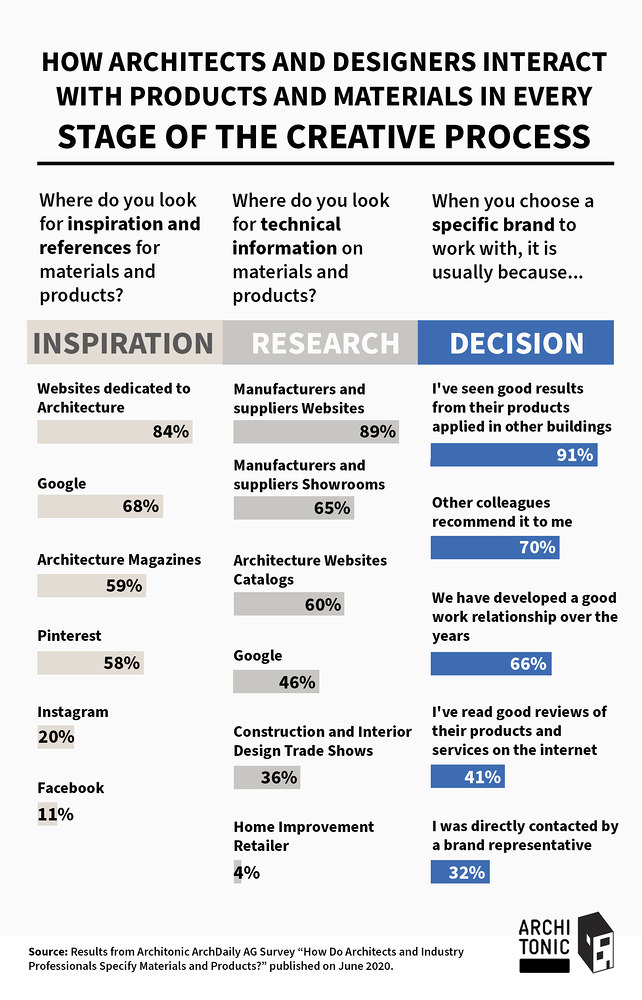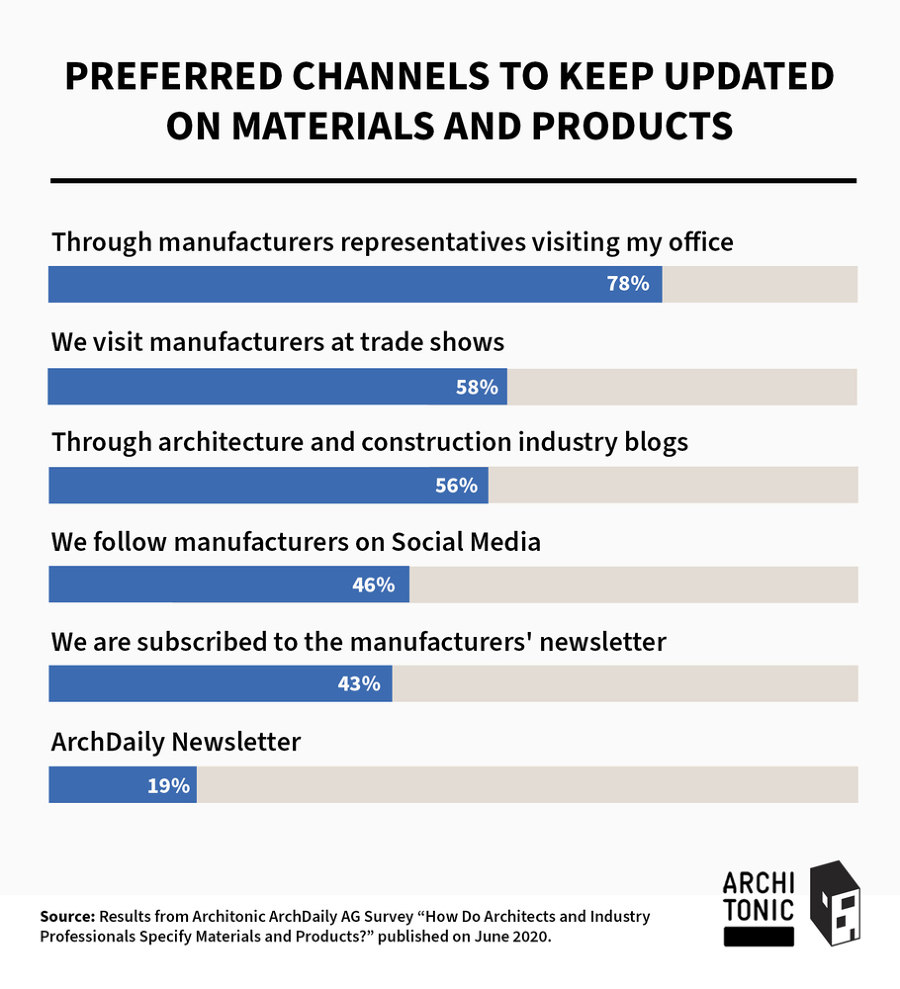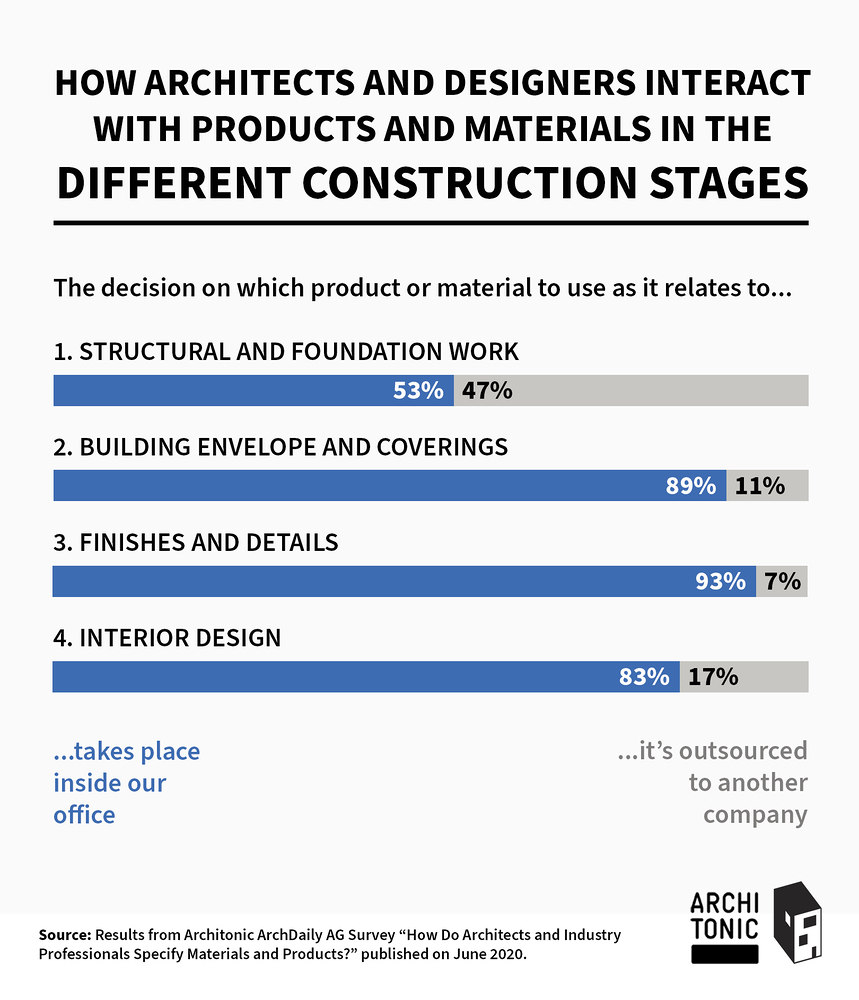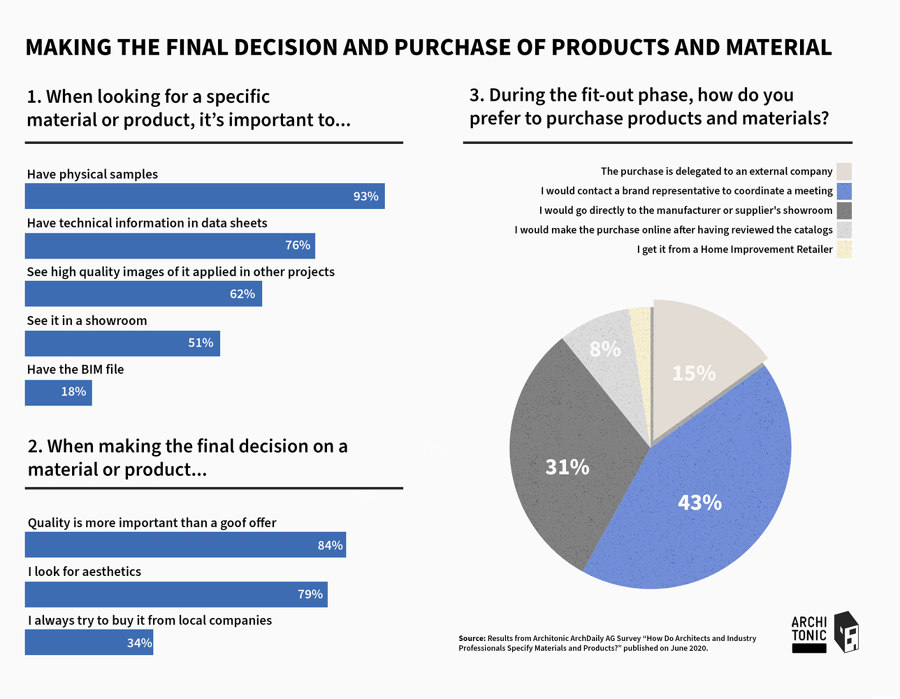Report: How Do Architects and Industry Professionals Specify Materials and Products?
Texte par Pola Mora
17.04.21
Last year we published a survey called "How do Architects and Industry Professionals Specify Materials and Products”. The objective was to better understand architects’ behaviors and needs during the specification stage of their design processes.
The following report is structured into 5 parts:
• Summary
• Who Took the Survey
• How do Architects and Designers Interact with Products and Materials in their Creative Process?
• Specifying Materials and Products in the Different Construction Stages
• Conclusions
Summary
The majority of architecture professionals who are designing and developing projects are also the key decision-makers when choosing and specifying the materials and products for their construction and interior design projects.
Although architects’ relationships with materials become more relevant during the construction phase; the initial design stages require research on referential material and technical queries that take place from the office, using what is available online.
Relationships between professionals in the architecture and design industry are a vital source of information when choosing the best materials and products to work with. Recommendations from other peers and the relationships built from previous experiences between architecture professionals and manufacturers play an important role in this stage.
The strengthening of digital channels such as industry blogs and newsletters, along with the increase of online purchases, suggest a new hybrid relationship between architects and materials in which in-person meetings with representatives and showroom visits can be combined with online shopping and research in order to optimize time and resources.
1. Who took the survey
The survey ran for three weeks in our English, Spanish and Portuguese sites, with 585 participants from 83 countries. Some of the countries that participated in this survey were the United States, United Kingdom, India, Chile, Mexico and Brazil. More than half of those surveyed were architects (70%) between the ages of 25 and 44 (60%), working either as freelancers (35%) or in small offices of up to 5 employees (32%).
Only 14% of those surveyed had a specific position in their office that was exclusively dedicated to the specification of materials and products. On the other hand, 96% stated that specification is part of their everyday tasks, in addition to designing. This overwhelming majority brought us to the conclusion that almost all architects or designers involved in the development of projects must, at one point or another, search for products and materials to specify in their designs.
2. How do Architects and Designers interact with Products and Materials in their Creative Process?
It is clear that architects and designers have a close relationship with materials throughout their entire creative process - from inspiration and research, to purchase and implementation. But which are the main channels and sources that they prefer to use when looking for concise information throughout the different project stages?
During the initial stage - the beginning of the creative process - the majority of architects and designers search for inspiration and references on materials and products by visiting architecture websites, such as ArchDaily (84%), and through search engines such as Google (68%). The third most common source of inspiration were specialized magazines (59%), followed closely by Pinterest (58%).
Although the digital space is widely used by architects these days, architecture and interior design continue to be disciplines that are developed in the physical world. This explains why some professionals mentioned visits to local projects as an important exercise when searching for inspiration on materials, allowing them to physically see how these have been adapted to previous works.
During the architect’s research stage, where they collect technical data on materials and products they are planning to use, professionals expect to find this information directly on manufacturers’ websites (89%). A smaller percentage also mentioned visits to showrooms (65%) and online catalogs (60%).
In the final stage, where the professional must choose which company or manufacturer will supply the materials and products for the project, the most important factor in decision-making was the ability to see the product successfully applied in another project (91%). This stage also included the importance of peer-to-peer recommendations (70%) and previous experiences between the architect and manufacturer, given the importance of building relationships with providers (66%).
In the Inspiration, Research and Decision stages, the behavior of the surveyees did not show significant variations per country. We start to see differences emerging between markets when it comes to the ways architects and design professionals keep updated on products and materials.
The responses collected through ArchDaily.com show how visits to architecture offices from manufacturer representatives currently are the main way in which architects and designers keep themselves updated on new materials and products (78%). It becomes clear that in the United States this is a common way of conducting business; however these practices may change because of the increase in professionals working from home, combined with new trends in online consumption.
In contrast, architecture and construction blogs are the main sources for Latin American professionals (71%) looking for updates. In both markets, however, the second most popular source are trade fairs.
3. Specifying Materials and Products in the Different Construction Stages
Every architectural project goes through the same stages: Structure and Foundation, Building Envelope and Coverings, Finishes and Details and, finally, Interior Design. Seeing as each stage requires different types of products and materials, we asked ourselves if there are also different ways to specify in each of these stages.
The first thing that caught our attention was that during the Structure and Foundation stage, for almost half of the offices, the specification tends to be outsourced to specialized companies. The two stages with the most in-house specification are Building Envelope and Coverings (89%) and Finishes and Details (93%)
When it comes to specifying products and materials for Interior Design, we can also see differences between markets. Brazil emerged as the market that most performs this type of specification in-house (93%), whereas the rest of Latin America drops to 78%, and the rest of the markets were at 82%.
In general, we found that architects and designers specify materials and products in a relatively uniform way throughout each construction stage. Regardless of whether they are searching for a specific structural material or a type of bathroom ceramic, the selection and purchasing processes seem to be the same. In any of these cases, the professionals tasked with specifying will firstly consider the availability of physical samples, followed by accessibility to technical information sheets and, lastly, the inclusion of high-quality product photos or photos of the product used in other projects. We might see an increase in relevance for digitally available technical information and high-quality images of products and materials in application. It would mean that this type of resource could be as important as physical samples, due to the shift that we are seeing in digital over physical.
When making the purchase, the majority of professionals prefer quality over price, followed by the appearance of the product and, lastly, locally produced or distributed products.
As for the professionals in charge of the purchasing of products and materials for their projects, the survey results indicate that the main options tend to be: direct contact with the manufacturers’ representatives and visiting suppliers’ showrooms, followed by the professional’s preference for online purchases. Our prediction is that the latter will increase considerably in the next few years, shifting into a new hybrid way of consumption in which in-person meetings with representatives and showroom visits can be combined with online shopping in order to optimize time and resources.
Finally, we also found that 15% of architects and designers do not make the purchase of materials, as this task is delegated to third party companies, which are usually construction companies.
4. Conclusions
The majority of architecture professionals who are designing and developing projects are also the key decision-makers when choosing and specifying the materials and products for their construction and interior design projects.
Although architects’ relationships with their chosen materials become more relevant during the construction phase; the initial design stages require research on referential material and technical queries that take place from the office, using what is available online. Architects and designers find inspiration in specialized websites and look for technical material in manufacturers’ and distributors’ websites. In the latter, it is important to note that although architects use these sites to find detailed product information, they sometimes are not able to find the exact information they seek, as these websites are not always built to house this type of technical material.
Relationships between professionals in the architecture and design industry are a vital source of information. Seeing previous experiences - whether from independent practitioners or architecture offices - and counting on peer-to-peer recommendations are key when deciding which materials to choose. It is during this stage that brands associated with previously built projects can remain in architects’ top-of-mind. If a good working relationship is forged between the manufacturer and the designer, where the manufacturer was able to provide relevant and timely information that contributed to the success of the project; it becomes more likely that the architect will return to that manufacturer before seeking other alternatives.
Architects and designers must be continuously up-to-date on new materials, product innovations, and new technologies. Being an industry that is so linked to the physical and built environment, the importance of attending trade fairs and in-person meetings are understandable. However, we are seeing the strengthening of digital channels such as industry blogs and newsletters, that consistently relay information directly to architects and designers’ devices.
Regarding the final decision and purchase, it seems quite logical that architects and designers are fans of seeing physical samples. That being said, there is an unmistakable global shift to online sales, which can in turn cause issues with the availability of samples. Online shopping for architectural materials and products is yet another step towards the digitization of our industry, which could benefit from the ready availability of technical information from manufacturers. This includes, among other things, the ability to show the final look of the applied product via high-quality photography. In-person meetings with representatives and showroom visits are industry staples, but these can be combined with online shopping to optimize time and resources. Our prediction is that the percentage of online product purchases will increase considerably in the next few years.
© Architonic


